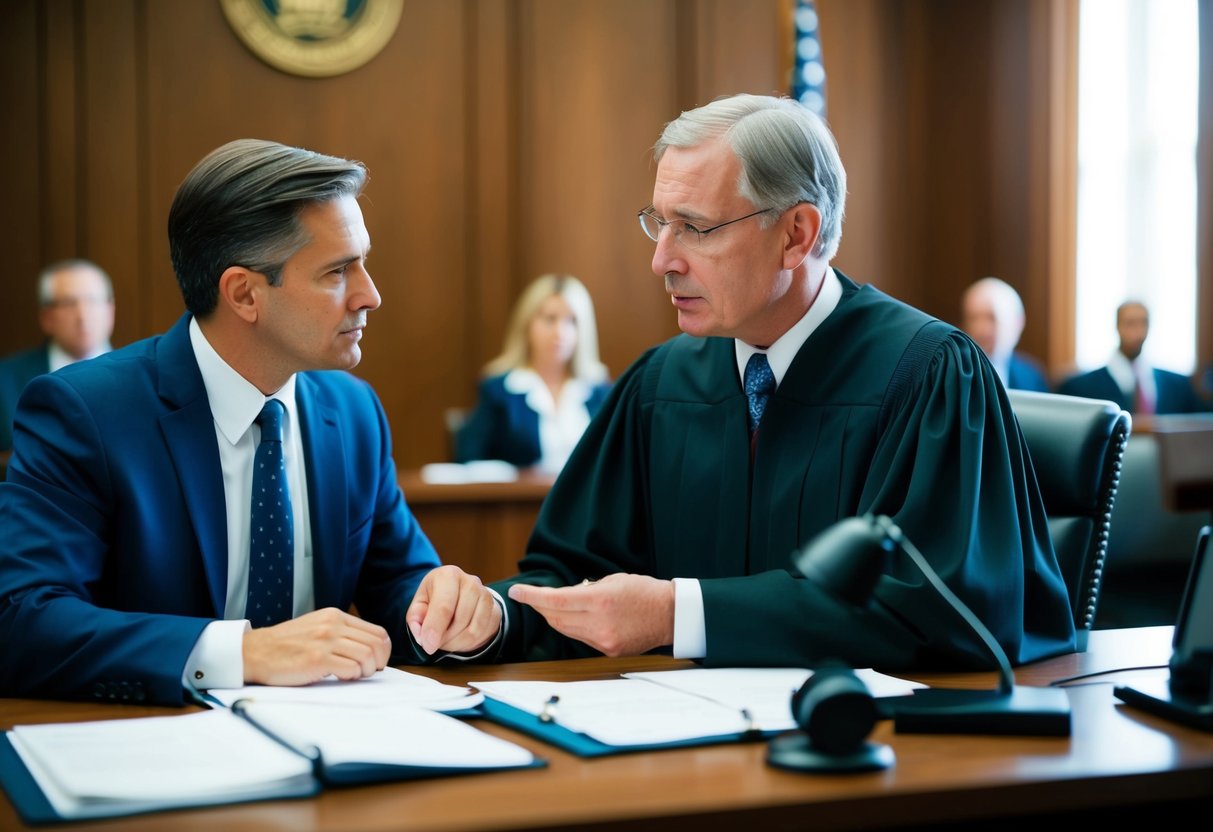Understanding Plea Bargaining

Plea bargaining is a vital part of the criminal justice system, offering a way for cases to be resolved without a full trial. It involves negotiations between the defense and the prosecution, with judges providing oversight. Plea bargaining has a significant impact on both defendants and the legal system itself.
Definition and Scope of Plea Bargaining
In plea bargaining, the defendant agrees to plead guilty to a lesser charge or to one of several charges. This agreement helps avoid a lengthy trial. We often see this in our legal system as a method to save time and resources.
- Charge Bargaining: Negotiating the charges faced.
- Sentence Bargaining: Negotiating the sentence length.
- Fact Bargaining: Negotiating over admitting certain facts.
Each type serves to streamline the justice process for defendants and prosecutors alike.
Historical Context and Legal Evolution
Plea bargaining has not always been a staple of the criminal justice system. It began gaining prominence in the 19th century. Initially, trials were the main method of resolving cases. However, as courts became busier, plea bargains provided efficiency and relief to clogged court systems.
With time, legal systems adapted to include plea bargaining formally. Legislation evolved to regulate these agreements. Today, it’s a common practice in courts, reflecting its importance in handling numerous cases efficiently.
Roles in Plea Bargaining: Defendant and Defense Attorneys
Defense attorneys play a crucial role in negotiating plea bargains. They evaluate the evidence and advise the defendant on possible outcomes. It’s our job to ensure defendants understand their rights and the consequences of accepting a plea deal.
Defendants must weigh the benefits and risks. A guilty plea might lead to a reduced sentence, but it also means accepting a criminal record. Defense attorneys guide defendants through this often complicated decision.
Judicial Oversight and the Role of Judges
Judges ensure fairness in plea bargains. We provide oversight by reviewing the terms of agreements and making sure they are legal and just. Judges also ensure defendants have entered agreements voluntarily without coercion.
Ultimately, judges hold the responsibility of approving plea deals. Although we rely on the prosecution and defense to negotiate terms fairly, it’s the judge’s job to uphold the integrity of the legal process.
The Plea Bargaining Process
In the plea bargaining process, both defense and prosecution play critical roles. We explore how plea deals are negotiated and the different forms they can take in criminal cases.
Stages of Plea Negotiations
Plea negotiations usually begin with discussions between the defense attorney and the prosecutor. Our aim is to reach an agreement that benefits both sides. The first stage often involves charge bargaining. This means negotiating to reduce charges in exchange for a guilty plea.
Once charge bargaining is agreed upon, the focus may shift to sentence bargaining. Here, both parties negotiate the length or type of sentence. Each stage involves careful negotiation, weighing the risks of going to trial against the potential benefits of a plea deal.
Types of Plea Bargains
We can identify several types of plea bargains that might occur during negotiations. Charge bargaining involves reducing charges to lesser offenses. This is common and often results in lesser penalties.
Sentence bargaining focuses on agreeing to a lighter sentence. This might occur when the accused agrees to plead guilty to more serious charges. Another type is fact bargaining, though it’s less common. This involves agreeing on certain facts to limit what can be presented in court.
These options provide flexibility in resolving criminal cases, potentially benefiting both the defense and prosecution.
Negotiation Process and Strategies
The negotiation process sometimes requires strategies to reach a satisfactory plea agreement. Our strategies include evaluating the strengths and weaknesses of the case. Strong evidence can skew negotiations in favor of the prosecution, impacting plea deals.
Effective communication between attorneys plays a vital role. Listening carefully and understanding expectations can aid success. Transparency in sharing information is crucial, yet strategic withholding may also be used. The goal is to ensure that the plea deal is acceptable to both parties, avoiding the uncertainties of a trial.
Critical Analysis of Plea Bargaining

The plea bargaining process plays a significant role in the criminal justice system. While it offers some advantages, it also presents potential risks and ethical challenges.
Ethical Considerations and Public Perception
Plea bargaining raises ethical questions. One concern is coercion, where defendants may feel pressured to plead guilty, even if they’re not. This can happen when they fear harsher sentences from a jury trial.
There are also constitutional rights to consider. Defendants might waive rights like a fair trial, impacting the integrity of the process. The public might see plea deals as a way for guilty people to avoid full accountability.
The innocent defendants issue is serious. Some might accept plea deals out of fear of worse outcomes. We need to address these ethical concerns to maintain trust in the justice system.
Pros and Cons of Plea Bargaining
Plea bargaining can speed up legal proceedings, reducing the burden on courts. This efficiency is vital for our system. It helps both the prosecution and defense by saving time and resources.
However, it also has downsides. Innocent defendants might plead guilty to avoid uncertain jury trial outcomes. This risk is a core concern in evaluating plea negotiations.
Finally, the guilty plea process can lead to lighter sentences, which might upset victims or the public. It is crucial to balance efficiency and fairness to ensure justice is served effectively.
Impact and Outcomes of Plea Bargaining
Plea bargaining has significant effects on both the outcome of cases and the efficiency of the court system. By agreeing to a plea deal, defendants can face different sentencing outcomes, while the court system benefits from quicker resolutions.
Effect on Sentencing and Case Resolution
Plea bargains often lead to reduced sentences for defendants. When they agree to plead guilty to a lesser offense, they might avoid harsher penalties. Count bargaining is another form that can result in fewer charges.
This can increase conviction rates as more people agree to guilty pleas. Victims might feel justice served swiftly, though sometimes finding outcomes too lenient.
However, lenient sentencing can become a concern. By accepting a plea deal, accused individuals might serve less time than if found guilty in a trial, leading to debates on fair justice.
Impact on the Court System and Justice System Efficiency
Plea deals greatly affect our court system through increased efficiency. With fewer cases going to trial, courts handle more cases quickly, reducing backlogs. This makes the entire justice system run more smoothly.
Although it speeds up case resolution, some argue it might reduce justice quality. When cases settle through plea bargaining, courts may miss the chance for deeper examinations.
For the court and justice system, plea bargaining offers both benefits and challenges. We commonly see more cases resolved rapidly. Yet, the method calls for careful consideration to maintain fairness and protect all parties involved.
Legal Precedents and Case Law
Legal precedents and case law play crucial roles in shaping the plea bargaining process. They influence how laws are interpreted and applied in criminal trials. Key Supreme Court decisions have impacted the legal process by clarifying rights and procedures, while landmark cases like Brady v. United States and Santobello v. New York have set important guidelines for plea negotiations.
Key Supreme Court Decisions
In the realm of plea bargaining, the Supreme Court has set significant precedents. These decisions ensure that defendants’ rights are protected during plea agreements. The Constitution plays a pivotal role here, helping structure the legal frameworks within which judges operate.
Judges rely on these decisions to maintain fairness. As a result, the legal process remains consistent across different cases. When plea agreements come under scrutiny, juries may also be influenced by these high court rulings.
Brady v. United States and Santobello v. New York
In Brady v. United States, the Court examined whether a guilty plea was valid when influenced by the threat of a harsher penalty after trial. This decision emphasized that for a plea to be valid, it must be made voluntarily, without coercion, and with a full awareness of the charges.
Santobello v. New York addressed the need for prosecutors to uphold any promises made during plea negotiations. It highlighted that if the terms of a plea deal were not fulfilled, the case could be overturned. Together, these cases underscore the importance of honesty and transparency in plea bargaining.




